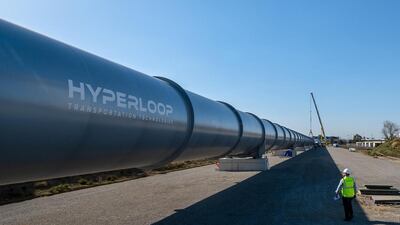Fifteen radical technologies will change the future and impact over $13 trillion (Dh47.8tn) worth of industries, according to a new report by Bank of America Merrill Lynch.
Some of these technologies — that BofA called “moonshots” in its report — include quantum computing, Hyperloop, nanosatellites, geoengineering, 6G, nuclear fusion, deep sea mining and nanotechnology.
“While moonshots start at a low market size, their disruptive nature means there is the potential for high growth,” said the report.
“These could be highly disruptive to industries worth a combined [size of] $13tn and contribute to the next 10- to 15-year cycle of intelligent technologies,” it added.
The evaluated moonshots generated revenue of $8.1 billion last year and this figure will go up to $48.4bn in 2025 — growing at a compound annual growth rate of 26 per cent.
Moonshots, with maximum growth potential, include quantum computing, deep sea mining and nanosatellites, whereas those expected to have the largest market size in 2025 are mass vertical farming, quantum computing and nanosatellites, according to the report’s findings.
“A paradigm shift in the explosion of data, doubling every two to three years, and the rise of an artificial intelligence driven world - [with] nearly 200 billion connectable devices by 2025 - will bring about the fastest roll-out of disruptive technologies in history," said the report.
Quantum computing, that could perform complex calculations in less than fractions of a second, could be one of the biggest science revolutions yet.
“Quantum computers could solve problems that would take traditional computers a billion years. Most affected sectors will include technology, financials, healthcare, infrastructure and energy,” said the report.
Although the possibility of a quantum computer was proposed as far back as in 1982, it was only in 2012 the first venture was undertaken to explore commercial uses. While still at a theoretical stage, Google stated its quantum computer model in development will be 100 million times faster than any conventional computer in its labs.
Fifth-generation (5G) cellular wireless networks — still in the initial stages of roll-out across the globe — will not be able to handle the exponential growth of data transmission in the next 10 years. A 5G network promises an internet speed of up to 1.2 gigabits per second which will gradually evolve to reach 10Gbps — more than 100 times faster than 4G.
Sixth-generation network could enable speeds up to 400 times faster than 5G, noted the report.
BofA said nanosatellites could play a crucial role in connecting nearly 41 per cent of the population that is still not connected to the internet. These are small satellites providing more affordable access to space and universal satellite internet access.
The global nano- and microsatellite market is set to grow at a 22.2 per cent compound annual growth rate over the next six years from $1.3bn in 2018 to $5.2bn in 2025.
Tech giant Amazon has already applied for permission to launch 3,236 satellites and it would positively impact the fields of space, military, telecoms, communications, science and remote sensing.
In the next 40 years, the planet will need to produce more food than all farmers have harvested in the past 8,000 years and next-generation food solutions such as vertical farming and lab-grown meat could be the answer, said the report.
“Solutions to optimise farming include growing plants in stacks on shelves, reducing the travel distance for produce and controlling growing environments to ensure year-round quality products.”
Vertical farming market is set to rise at a 24.6 per cent CAGR to $12.77bn by 2026 from $2.23bn in 2018
To develop the right moonshots that successfully result in disruptive outcomes, some key elements are also needed.
“These technologies must have the potential to be economical and cost-competitive. Besides, there should be mass adoption of new products that must address a gap in the market and solve a key problem … such as climate change or improve the quality of life,” noted the report.


